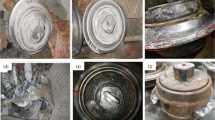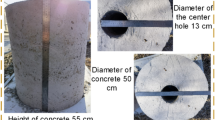Abstract
Stress control was very important for the application of laser cladding technology, but there was still not an effective method at present, so a stress control method, including longitudinal critically refracted (Lcr) wave method and ultrasonic vibration method, was proposed, but its correlation was still not clear. Therefore, based on the longitudinal critically refracted (Lcr) wave acoustoelastic theory, the ultrasonic vibration effect on Lcr wave acoustoelastic coefficient of laser cladding coating was discussed. In this study, laser cladding coatings applied with 0, 10, 50 and 90% of the maximum ultrasonic vibration amplitude were prepared on surface of carbon steel, and the Lcr wave system for measuring stress consisting of a ultrasonic wave generator, a digital oscilloscope, two Lcr wave transducers (including one transmitting transducer and one receiving transducer) and a self-designed transducer clamp was employed. To explain experimental results, the microstructure and fracture morphology of laser cladding coating were observed by metallurgical microscope and SEM. The results show that although the ultrasonic vibration amplitudes are different, the relationships between difference in propagation time of Lcr wave and stress are almost consistent with the Lcr wave acoustoelastic theory. As the ultrasonic vibration amplitude increasing, the Lcr wave acoustoelastic coefficient of laser cladding coating becomes higher and higher gradually. While compared with the Lcr wave acoustoelastic theory, there are some differences in experimental results including fluctuation of difference in propagation time of Lcr wave, the difference in turning point stress and yield strength of laser cladding coating. At last, the experimental results were discussed, and the changes of microstructure, including the dendrite broken and grain refinement, caused by ultrasonic vibration effect are seen as the main reasons.









Similar content being viewed by others
References
L. Chen, K.R. Luo, B.H. Li, M.Y. Hu, and J. Feng, Mechanical Property Enhancements and Amorphous Thermal Transports of Ordered Weberite-Type RE3Nb/TaO7 High-Entropy Oxides [J], J. Adv. Ceram., 2023, 12(2), p 399–413.
L. Chen, B.H. Li, J. Guo, Y.K. Zhu, and J. Feng, High-Entropy Perovskite RETa3O9 Ceramics for High-Temperature Environmental/Thermal Barrier Coatings [J], J. Adv. Ceram., 2022, 11(4), p 556–569.
Y.L. Feng, X.T. Pang, K. Feng, Y.Q. Feng, and Z.G. Li, Residual Stress Distribution and Wear Behavior in Multi-pass Laser Cladded Fe-Based Coating Reinforced by M3(C, B), J. Mater. Res. Technol., 2021, 15, p 5597–5607.
L. Meng, B.B. Zhu, Q.W. Hu, and D.Z. Wang, Laser-Induction Hybrid Cladding of Different Coatings on Rail Surface: Microstructure, Wear Properties and Contact Fatigue Behaviors, Appl. Surf. Sci., 2021, 566, 150678.
Q. **ao, W.L. Sun, K.X. Yang, X.F. **ng, Z.H. Chen, H.N. Zhou, and J. Lu, Wear Mechanisms and Micro-evaluation on WC Particles Investigation of WC-Fe Composite Coatings Fabricated by Laser Cladding, Surf. Coat. Technol., 2021, 42, 127341.
Y. Liu, Y. Ding, L. Yang, R. Sun, T. Zhang, and X. Yang, Research and Progress of Laser Cladding on Engineering Alloys: A Review, J. Manuf. Process., 2021, 66, p 341–363.
N. Hashemi, A. Mertens, H.M. Montrieux, J.T. Tchuindjang, O. Dedry, and R. Carrus, Oxidative Wear Behaviour of Laser Clad High Speed Steel Thick Deposits: Influence of Sliding Speed, Carbide Type and Morphology, Surf. Coat. Technol., 2017, 315, p 519–529.
L. Zhu, P. Xue, Q. Lan, G. Meng, Y. Ren, and Z. Yang, Recent Research and Development Status of Laser Cladding: A Review, Opt. Laser Technol., 2021, 138, 106915.
L.D. Zhu, S.H. Wang, H.C. Pan, C.T. Yuan, and X.S. Chen, Research on Remanufacturing Strategy for 45 Steel Gear using H13 Steel Powder Based on Laser Cladding Technology, J. Manuf. Process., 2020, 49, p 344–354.
X.Y. Jiao, J. Wang, C.M. Wang, Z.Q. Gong, X.X. Pang, and S.M. **ong, Effect of Laser Scanning Speed on Microstructure and Wear Properties of T15M Cladding Coating Fabricated by Laser Cladding Technology, Opt. Laser Eng., 2018, 110, p 163–171.
B. Liu, Y.M. Yu, R.F. Li, J.Y. Gu, and P. He, Effect of Ultrasonic Impact Treatment on Surface Stress Evaluation of Laser Cladding Coating by using Critically Refracted Longitudinal Wave, Surf. Coat. Technol., 2021, 421, 127484.
B. Liu, Z.H. Zeng, J.Y. Gu, S.J. Chen, P. He, and J.X. Fang, Burial Depth Effect of Crack on the Lcr Wave Acoustoelastic Coefficient for Stress Measurement of Laser Cladding Coating, Mater, 2020, 6(13), p 2823–2833.
E. Liu, Y. Liu, Y. Chen, X.M. Wang, H.P. Ma, C.Z. Sun, and J.B. Tan, Measurement method of bolt hole assembly stress based on the combination of ultrasonic longitudinal and transverse waves, Appl. Acoust., 2022, 189, p 108603.
B. Liu, J.M. Li, S.Y. Dong, and F.Y. Shu, Correction for Microstructure Effect on Residual Stress Measurement of SR-FSW Joint with Lcr Wave, Russ. J. Nondestruct. Test., 2020, 56, p 131–140.
B. Liu, W.B. Miao, Sy. Dong, and P. He, Grain Size Correction of Welding Residual Stress Measurement in a Carbon Steel Plate using the Critical Refraction of Longitudinal Waves, Res. Nondestruct. Eval., 2019, 30, p 112–126.
B. Liu, W.B. Miao, S.Y. Dong, and P. He, Grain Size Effect on Lcr Elastic Wave for Surface Stress Measurement of Carbon Steel, Nondestruct. Test. Eval., 2018, 33, p 139–153.
Y. Liu, C.J. Wang, and R.G. Bi, Acoustic Residual Softening and Microstructure Evolution of T2 Copper Foil in Ultrasonic Vibration Assisted Micro-tension, Mater. Sci. Eng. A, 2022, 841, 143044.
J. Liao, L.X. Zhang, H.L. **ang, and X. Xue, Mechanical Behavior and Microstructure Evolution of AZ31 Magnesium Alloy Sheet in an Ultrasonic Vibration-Assisted Hot Tensile Test, J. Alloy. Compd., 2022, 895, 162575.
M.Y. Li, Q. Zhang, B. Han, L.X. Song, G. Cui, J. Yang, and J.L. Li, Microstructure and Property of Ni/WC/La2O3 Coatings by Ultrasonic Vibration-Assisted Laser Cladding Treatment, Opt. Laser Eng., 2020, 125, 105848.
Y.J. Shen, X.F. Li, and X.Y. Chen, Effect of Ultrasonic Power on Microstructure and Properties of Fe-Cr-V-C Coating by Laser Cladding, Trans. China Weld. Inst., 2017, 38(5), p 74–79.
L. Yao, H. Hao, and S.H. Ji, Effects of Ultrasonic Vibration on Solidification Structure and Properties of Mg-8Li-3Al Alloy, Trans. Nonferrous Met. Soc. China, 2011, 21, p 1241–1246.
C. Li, Y.P. Yang, Z.T. Liu, X. Han, and T.H. Jia, Differential Analysis of the Influence Mechanism of Ultrasonic Vibrations on Laser Cladding, CIRP J. Manuf. Sci. Technol., 2022, 38, p 16–37.
M. Zhang, G.L. Zhao, X.H. Wang, S.S. Liu, and W.L. Ying, Microstructure Evolution and Properties of In-Situ Ceramic Particles Reinforced Fe-Based Composite Coating Produced by Ultrasonic Vibration Assisted Laser Cladding Processing, Surf. Coat. Technol., 2020, 403, 126445.
M.Y. Li, B. Han, Y. Wang, L.X. Song, and L.Y. Guo, Investigation on Laser Cladding High-Hardness Nano-Ceramic Coating Assisted by Ultrasonic Vibration Processing, Optik, 2016, 127, p 4596–4600.
A. Malvandi, R. Kapoor, H. Feng, and M. Kamruzzaman, Non-destructive Measurement and Real-Time Monitoring of Apple Hardness during Ultrasonic Contact Drying via Portable NIR Spectroscopy and Machine Learning, Infrared Phys. Technol., 2022, 122, 104077.
D.D. Zhuang, B. Du, S.H. Zhang, W.W. Tao, Q. Wang, and H.B. Shen, Effect and Action Mechanism of Ultrasonic Assistance on Microstructure and Mechanical Performance of Laser Cladding 316L Stainless Steel Coating [J], Surf. Coat. Technol., 2022, 433, 128122.
R. Börner, M. Göltz, T. Helmreich, A. Schuberta, and S. Rosiwal, Surface Microstructuring of Steel Components for CVD Diamond Coating by Ultrasonic Vibration Superimposed Face Milling using Tailored Tools Vibration-Assisted Laser Cladding Treatment, Procedia CIRP, 2020, 87, p 234–239.
H. Liu, Q. Xu, C. Wang, and X. Zhang, Corrosion and Wear Behavior of Ni60CuMoW Coatings Fabricated by Combination of Laser Cladding and Mechanical Vibration Processing, J. Alloy. Compd., 2015, 621, p 357–363.
D.S. Hugues and J.L. Kelly, Second-Order Elastic Deformation of Solid, Phys. Rev., 1951, 92, p 1145–1149.
R.B. Thompson, W.Y. Lu, and A.V. Clark, Ultrasonic methods, Handbook of Measurement of Residual Stresses. J. Lu Ed., Society Expe Mech, Bethel (CT), 1996, p 149–178
B. Liu and S.Y. Dong, Anisotropic Structure Affects Thickness Measurement of Laser Cladding Coating with Surface Ultrasonic Wave Based on Cross-Correlation Function, Mater. Res. Innov., 2015, 19, p 1–5.
Acknowledgment
The paper was financially supported by National Natural Science Foundation of China (Grant number 52275193); Key Foundation (2021-JCJQ-JJ-0184) and Key Project (2021-JCJQ-ZD-302); Jiangsu University “qinlangongcheng”; Jiangsu Province “Liudarencaigaofeng.”
Author information
Authors and Affiliations
Corresponding authors
Additional information
Publisher's Note
Springer Nature remains neutral with regard to jurisdictional claims in published maps and institutional affiliations.
Rights and permissions
Springer Nature or its licensor (e.g. a society or other partner) holds exclusive rights to this article under a publishing agreement with the author(s) or other rightsholder(s); author self-archiving of the accepted manuscript version of this article is solely governed by the terms of such publishing agreement and applicable law.
About this article
Cite this article
Yuan, M., Liu, B., Dong, L. et al. Influence of Ultrasonic Vibration on Longitudinal Critically Refracted (Lcr) Wave Acoustoelastic Coefficient for Evaluating Coating Stress. J. of Materi Eng and Perform (2024). https://doi.org/10.1007/s11665-024-09359-w
Received:
Revised:
Accepted:
Published:
DOI: https://doi.org/10.1007/s11665-024-09359-w




